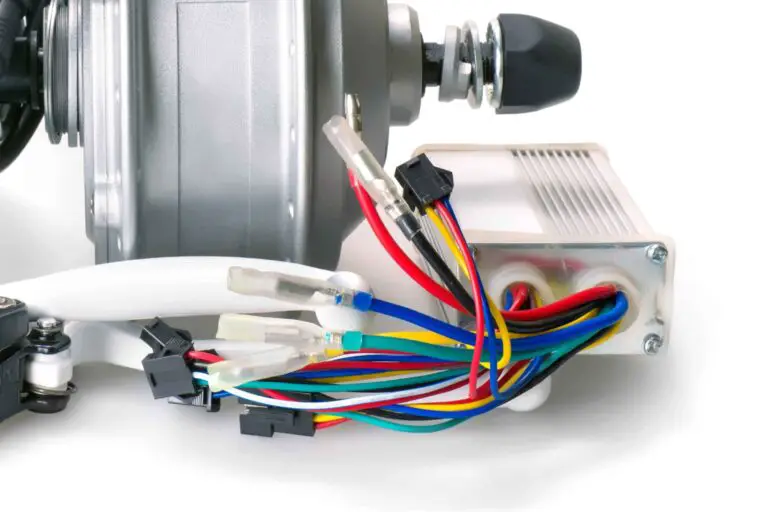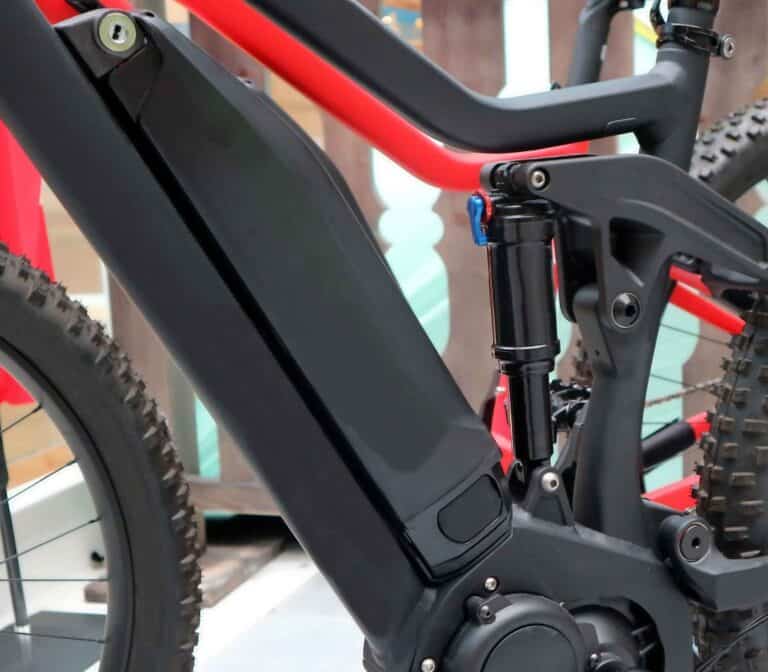Lithium Ion eBike Battery Vs. Lifepo4 (Just The Raw Facts)
Electric bike batteries are made of different cell compositions. The e-bikes I have owned so far have lithium-ion battery cells, but I’ve heard a lot about LiFePO4. While some riders prefer lithium-ion batteries, there are also quite a lot who would choose LiFePO4 . What really is the difference between the two?
As a whole, lithium-ion and LiFePO4 electric bike batteries differ in their chemical composition. The latter uses lithium iron phosphate as a cathode, while the former makes use of either lithium manganese oxide or lithium cobalt dioxide as a cathode.
On average, LiFePO4 e-bike batteries have a greater lifespan than lithium-ion e-bike batteries. Lithium-ion electric bike batteries typically have a lifespan of 300-500 life cycles, while LiFePO4 electric bike batteries can exceed 2000 life cycles.
As a general rule, lithium-ion electric bike batteries have higher density compared to LiFePO4 electric bike batteries, meaning they also have a much higher capacity. Consequently, lithium-ion e-bike batteries can run for longer durations.
In this article, we will delve into the differences between lithium-ion electric bike batteries and LiFePO4 eBike batteries, exploring their pros and cons, and addressing common questions related to these two power sources.
What is the Difference Between a Lithium Ion eBike Battery and a Lifepo4 eBike Battery?
As a general rule, the difference between lithium-ion and LiFePO4 e-bike batteries lies in their chemistry. The lithium-ion battery uses lithium manganese oxide or lithium cobalt dioxide as a cathode, whereas LiFePO4 batteries use lithium iron phosphate as a cathode.
There are lots of differences between lithium-ion and LiFePO4 batteries, with the first notable distinction lying in their chemistry. LiFePO4 batteries utilize lithium iron phosphate as the cathode, while lithium-ion batteries use either lithium manganese oxide or lithium cobalt dioxide.
Due to their chemical structures, LiFePO4 batteries tend to be a lot safer than lithium-ion batteries. This is because LiFePO4 batteries have higher thermal stability. Consequently, the risk of overheating is reduced.
Additionally, LiFePO4 batteries tend to have a longer lifespan than lithium-ion batteries. LiFePO4 batteries typically have lifecycles ranging from 300 to 500, approximately translating to 3 to 5 years. In contrast, lithium-ion batteries typically have lifecycles exceeding 2000, equating to a lifespan of about 5 to 10 years.
Furthermore, a notable distinction between the two batteries lies in their densities. Lithium-ion batteries boast higher density compared to LiFePO4 batteries, and this higher density translates to increased capacity. Therefore, lithium-ion batteries have a higher capacity compared to LiFePO4 batteries. Nevertheless, LiFePO4 battery packs can still achieve comparable capacity to lithium-ion batteries, but they need to use more LiFePO4 battery cells, which in turn leads to a heavier overall weight.
Pros and Cons of Lithium Ion eBike Battery
| Pros of Lithium-ion eBike Battery | Cons of Lithium-ion eBike Battery |
| Lithium-ion batteries exhibit high battery density, leading to increased battery capacity and, consequently, a longer run time. | A high-quality lithium-ion e-bike battery tends to be a bit expensive. |
| Lithium-ion batteries typically have a lifespan of about 3-5 years when well-maintained. | They have a long lifespan but are much lower compared to LiFePO4 e-bike batteries. |
| Lithium-ion batteries are widely utilized in diverse electrical devices, including electric bikes. | Lithium-ion batteries have low thermal stability, making them sensitive to overcharging or overheating. |
| Lithium-ion e-bike batteries are rechargeable, allowing you to charge them when they are already drained. | It is not advisable to always fully charge and discharge the lithium-ion battery, as it can reduce the battery performance. Instead, it is recommended to discharge your battery down to 20% and charge it up to 80-90%. Perform a full charge and discharge cycle once in a while. |
| Lithium-ion batteries can be connected in series or parallel configurations, enabling them to achieve a much higher capacity. | |
| Lithium-ion battery cells are compact and light. Therefore, when assembled into battery packs, they tend to be lightweight compared to other rechargeable batteries. | |
| There are many lithium-ion e-bike battery packs available for purchase, providing numerous options depending on your preferences. | |
| Lithium-ion batteries can charge very quickly, reducing concerns about high electric bills. |
Pros and Cons of LiFePO4 eBike Battery
| Pros of Li LiFePO4 eBike Battery | Cons of LiFePO4 eBike Battery |
| LiFePO4 batteries have a longer lifespan, typically exceeding 2000 cycles, equivalent to about 5-10 years. | A high-quality LiFePO4 e-bike battery tends to be a bit expensive. |
| LiFePO4 batteries have high thermal stability, which could result in increased safety as they are not very sensitive to overcharging or overheating. | They are great batteries to be used in e-bikes. However, LiFePO4 e-bike battery packs have limited availability. |
| LiFePO4 batteries have stable chemistry. | |
| LiFePO4 batteries are utilized in diverse electrical devices, including electric bikes. | LiFePO4 e-bike batteries have lower densities, resulting in a lower capacity compared to lithium-ion batteries with the same configuration. |
| LiFePO4 batteries are environmentally friendly. | LiFePO4 batteries can achieve as much capacity as lithium-ion battery packs, but they require more LiFePO4 cells, which could result in a heavier weight. |
| Lithium-ion batteries can charge very quickly, reducing concerns about high electric bills. |
Lithium-Ion eBike Battery Vs. Lifepo4 eBike Battery
| eBike Battery | Lithium-Ion eBike Battery | Lifepo4 eBike Battery |
| Cost of Purchase | Relatively high | Relatively high |
| Maintenance Cost | Starts at $0 | Starts at $0 |
| Running Cost | More or less $5 | More or less $5 |
| Range | Higher | Lower |
| Safety | Lesser safe | Safer |
| Reliability | Reliable | Reliable |
| Life Span | 3-5 years | 5-10 years |
| Availability | More available | Limited |
Cost of Purchase: Lithium-Ion eBike Battery Vs. Lifepo4 eBike Battery
The purchase cost of lithium-ion and LiFePO4 electric bike batteries varies depending on factors such as battery configurations, overall capacity, manufacturer, and the safety technology incorporated into the battery. Generally, LiFePO4 batteries might be slightly more expensive than lithium-ion counterparts. However, considering their longer lifespan, they can be more cost-effective in the long run. It is important to note that prices may change.
| Lithium-ion eBike Batteries | Cost | LiFePO4 eBike Batteries | Cost |
| 36V 13AH 468WH BMS25A | $217 | 24V, 10Ah LFP Battery (PVC, BLF-2410A) | Battery only- $189.99Battery with charger- $229.99 |
| H Hailong 24V 20Ah eBike Battery | $215.99 | 24V, 20Ah LFP Battery (PVC, BLF-2420A) | Battery only- $369.99Battery with charger- $409.99 |
| D034 Li Ion Battery 36V 15Ah | $349 | 24V, 40Ah LFP Battery (PVC, BLF-2440A) | Battery only- $739.98Battery with charger- $779.99 |
| 48V 10AH LI-ION DOWNTUBE E-BIKE BATTERY | $764 | High Energy Density Lifepo4 Bms 48v UL1642 Certificate for Electric Vehicle | – |
| 52V 12.8Ah Polly Downtube – Lithium Ion Battery – Panasonic Cells | $599 | LifePo4 Lithium 72V 20AH Electric Bike Battery | – |
Maintenance Cost: Lithium-Ion eBike Battery Vs. Lifepo4 eBike Battery
There is not much significant difference in the maintenance cost between Lithium-ion and LiFePO4 electric bike batteries. Electric bike batteries generally do not require regular repairs and maintenance; instead, proper usage is key. In most cases, maintenance costs arise only when a repair is necessary. The maintenance cost is determined by the professional fees you have to pay, which may depend on the mechanic or the issue with your e-bike battery. The price of the e-bike battery as a replacement will also add up to the maintenance cost.
Running Cost: Lithium-Ion eBike Battery Vs. Lifepo4 eBike Battery
The running cost of both lithium-ion and LiFePO4 electric bike batteries depends on the charging cost, influenced notably by factors such as battery capacity, local electricity rates, charging duration, and more. Even when both LiFePO4 and lithium-ion batteries boast the same capacity, variations in charging times could result in differing charging costs. Technically, the battery that takes longer to charge has a higher charging cost. In most cases, the charging time may depend on the type of charger used.
Range: Lithium-Ion eBike Battery Vs. Lifepo4 eBike Battery
The range of any electric bike battery can be significantly affected by several factors, such as overall cargo and rider’s weight, riding style, weather, riding speed, level of pedal assist used, and more. However, when it comes to the range of LiFePO4 and lithium-ion electric bike batteries ridden in similar situations, lithium-ion emerges as the clear winner. This is because lithium-ion batteries have higher densities compared to LiFePO4 batteries, translating to much higher battery capacities. Therefore, if a lithium-ion and LiFePO4 e-bike battery with the same number of cells are compared, the e-bike battery pack made of lithium-ion cells will typically run longer than that of a LiFePO4 e-bike battery pack. However, LiFePO4 could still attain a similar capacity as lithium-ion but would require more battery cells, making them heavier and bulkier.
Safety: Lithium-Ion eBike Battery Vs. Lifepo4 eBike Battery
When considering the safety of handling lithium-ion and LiFePO4 electric bike batteries, the LiFePO4 battery pack emerges as the winner. LiFePO4 batteries exhibit high thermal stability, allowing them to handle elevated temperatures while maintaining optimal performance. In contrast, lithium-ion batteries are more sensitive to overheating, requiring extra care to preserve their optimal performance. Due to the lower thermal stability of lithium-ion compared to LiFePO4 electric bike batteries, they are more susceptible to the risk of fire. Nevertheless, it is crucial to note that, regardless of the e-bike battery type you have, handling them with proper care and usage is essential for your safety.
Reliability: Lithium-Ion eBike Battery Vs. Lifepo4 eBike Battery
When it comes to reliability, both lithium-ion and LiFePO4 batteries are dependable choices for electric bikes. They each have their advantages and disadvantages, but both perform exceptionally well, especially when properly maintained and used. Regardless of whether you choose lithium-ion or LiFePO4, as long as you purchase an e-bike battery pack from a trusted manufacturer or seller, you can rest assured about its reliability. That’s why it is important to thoroughly check both the battery and the company before making a purchase.
Life Span: Lithium-Ion eBike Battery Vs. Lifepo4 eBike Battery
The lifespan of e-bike batteries is a crucial factor for most of us when making a purchase. In this regard, LiFePO4 e-bike batteries emerge as an excellent option. LiFePO4 batteries tend to last longer than lithium-ion e-bike batteries, boasting a lifecycle exceeding 2000 cycles, equivalent to about 5-10 years of use. In contrast, lithium-ion batteries typically have lifecycles of about 300-500, translating to approximately 3-5 years of use. However, with proper usage and maintenance, both lithium-ion and LiFePO4 batteries can achieve a much longer lifespan than initially expected.
Availability: Lithium-Ion eBike Battery Vs. Lifepo4 eBike Battery
Both lithium-ion and LiFePO4 batteries are commonly used in electric bikes. However, when considering the availability of e-bike battery packs made with these cells, there are more lithium-ion options compared to LiFePO4 batteries. Therefore, if you prefer having a wide range of choices based on your budget, battery capacity, and other preferences, you’ll find more options with lithium-ion battery packs.
“Batteries are the most dramatic object. Other things stop working or they break, But Batteries… They Die.”-Demetri Martin
Is LiFePO4 a Lithium Ion?
As a general rule, LiFePO4 is not a lithium-ion battery. LiFePO4 and lithium-ion are both sub-types of lithium batteries, but they have distinctive characteristics, one of which lies in their chemistries.
In a much broader sense, LiFePO4 batteries are considered a subtype of lithium-ion batteries. However, in comparison to traditional lithium-ion batteries, LiFePO4 batteries use lithium iron phosphate as a cathode, while traditional lithium-ion batteries use lithium manganese oxide or lithium cobalt dioxide. Due to their distinctive chemical characteristics, they are often classified as two different types of batteries. Though both types are utilized in a wide range of electric devices, including e-bikes, they each come with their own set of advantages and disadvantages.
For instance, LiFePO4 batteries are known for their longer lifespan, higher thermal stability, and increased safety. However, though they can be used for e-bike applications, the availability of their battery packs for e-bikes is limited. Furthermore, they also have lower battery density, which means they have lower capacity, translating to a shorter runtime.
On the other hand, lithium-ion batteries are known for their higher density. Hence, they have a much longer runtime compared to LiFePO4 batteries. Additionally, they are widely used in the electric bike market, so you have lots of options to choose from. However, compared to LiFePO4 batteries, they have lower lifespans; however, they can still last significantly for about 3-5 years of use. Lithium-ion batteries should also be handled with extra care as they are very sensitive to overheating.
What Kind of Battery is a LiFePO4?
As a whole, LiFePO4 is a type of lithium battery and, in a broader sense, is considered a subtype of lithium-ion (rechargeable) batteries. Compared to traditional lithium-ion batteries, LiFePO4 uses lithium iron phosphate as a cathode.
Compared to traditional lithium-ion batteries that use lithium manganese oxide or lithium cobalt dioxide as a cathode, LiFePO4 utilizes lithium iron phosphate, offering several advantages, including a longer cycle life, higher thermal stability, and increased safety characteristics.
If you are planning to build your own e-bike battery pack using LiFePO4 battery cells, you can watch the video below to gain insights.
Is Lithium Ion Better Than LiFePO4?
On average, lithium-ion batteries are better than LiFePO4 batteries in terms of battery capacity but not in lifespan, safety, and thermal stability. Lithium-ion batteries have higher densities, so they have higher capacities in a very compact and lightweight form.
Lithium-ion batteries beat LiFePO4 batteries in terms of runtime, weight, and availability. However, when it comes to lifespan, safety, and thermal stability, LiFePO4 is clearly the winner. Nevertheless, lithium-ion batteries still perform well when used in e-bikes and can be significantly safe if the battery pack is created with safety features and used properly. So, when looking for an electric bike battery, choose the one that suits your preferences.

Why is LiFePO4 So Expensive?
As a whole, LiFePO4 batteries are expensive because the raw materials used to manufacture them are generally expensive. Another factor that affects the price of any battery is the integration of safety features and advanced technology, which adds up to the overall manufacturing cost.
Though LiFePO4 batteries are generally expensive, they can be very cost-efficient in the long run because LiFePO4 batteries have a lifecycle of more than 2000, equivalent to 5-10 years of use. They also have higher thermal stability, allowing them to handle extreme temperatures without a significant reduction in performance.
Which is Better LiFePO4 Vs. LiPo?
As a general rule, when it comes to determining which battery is better, the primary answer would depend on your own preferences and specific requirements, as these batteries have their own advantages and disadvantages.
If you’re seeking a battery with significantly longer runtime, the LiPo battery emerges as the superior choice. LiPo batteries boast a much higher energy capacity, leading to extended usage. Moreover, if your priority is a battery that offers a lighter weight in a compact form, opting for a LiPo battery proves advantageous. The higher energy density of LiPo batteries means that fewer battery cells are required to achieve the same capacity compared to LiFePO4 batteries. Therefore, if weight and a compact form are essential for your specific application, LiPo stands out as the better choice.
However, if safety and a longer lifespan are your priorities, we highly recommend opting for LiFePO4 batteries. LiFePO4 batteries exhibit much higher thermal stability, enabling them to handle extreme temperatures effectively and minimizing the risk of potential fires. Additionally, LiFePO4 batteries can be very cost-efficient in the long run due to their extended lifespan compared to LiPo batteries.
If you are having issues with your electric bike battery, you can check our article ‘E-bike Battery Problems (A Fix That Actually Works)‘ to gain insights on how you can possibly fix them.






